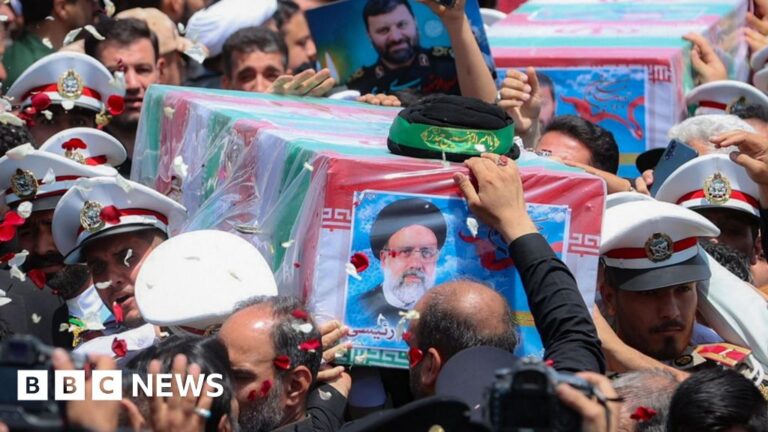Late Iranian President Ebrahim Raisi is buried in his hometown of Mashhad, four days after he was killed in a helicopter crash.
The 63-year-old hardline cleric will be laid to rest in the holy shrine of Imam Reza, a revered figure in Shiite Islam.
Television images showed large crowds gathering on one of the northeastern city’s main streets ahead of the ceremony.
Seven other people died in Sunday’s accident, caused by bad weather in Iran’s mountainous northwest.
Among them was Raisi’s foreign minister, Hossein Amir-Abdollahian, who was buried Thursday at the Shah Abdolazim shrine in Rey, a southern suburb of the capital Tehran.
Ebrahim Raisi’s burial at the golden-domed Imam Reza shrine – a memorial to the eighth Shiite imam, considered Iran’s holiest – comes after days of ceremonies elsewhere.
On Wednesday, leaders and other dignitaries from the country’s allies and neighbors attended a commemorative event in Tehran.
They were welcomed by Raisi’s former first vice-president, Mohammad Mokhber, 68, who will serve as interim president until elections are held on June 28.
Also present were representatives of the so-called “Axis of Resistance,” an informal network of armed groups that receive Iranian weapons, training and funds.
Among them were the political leader of the Iranian-backed Palestinian armed group Hamas, Ismail Haniyeh, the deputy secretary general of the Lebanese Hezbollah movement, Naim Qassem, the spokesperson for Yemen’s Houthis, Mohammed Abdulsalam, and the head of the paramilitary forces of Iraqi popular mobilization, Faleh. al-Fayad.
Iran’s Supreme Leader Ayatollah Ali Khamenei also led prayers for those killed.
Raisi was close to the 85-year-old, who is the Islamic Republic’s top authority, and was widely seen as a potential successor.
Senior Western officials were noticeably absent from Wednesday’s ceremony, reflecting their countries’ strained relations with Iran.
Tens of thousands of people took part in funeral processions in recent days, which the government and state media described as displays of national unity.
However, many more people stayed home, with some even celebrating the president’s death despite warnings from prosecutors that they could face prosecution.
Millions despised Raisi for overseeing the deadly crackdown on the “Woman, Life, Liberty” protests that erupted in 2022, a year after he took office.
He has also been the subject of calls for an international investigation into his alleged role in the “death committee” that ordered mass executions of political prisoners in the 1980s.
His tenure as president will also be remembered for growing economic woes and an unprecedented direct military confrontation with Israel last month that raised fears of a regional war.
Iranian authorities say they are still investigating the causes of the helicopter crash in which he died.
Officials said the plane – a decades-old American-made Bell 212 – hit the side of a mountain while heading toward the northwest city of Tabriz in fog and heavy rain.
Raisi was traveling with Amir-Abdollahian, the governor of East Azerbaijan province, Malek Rahmati, and the leader of the Friday prayers of Tabriz, Ayatollah Mohammad Ali Al-e Hashem, as well as the head of the team presidential security and the three helicopter crews after the inauguration. of two dams on the border with Azerbaijan.


